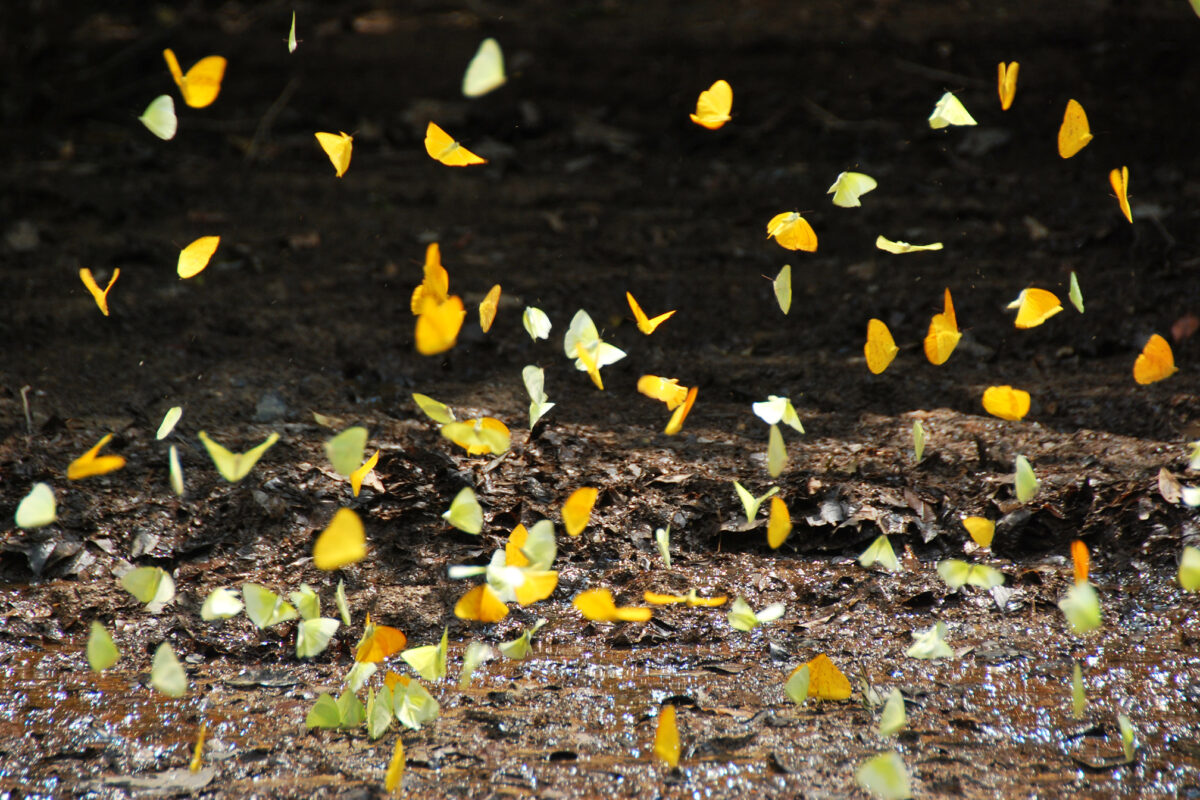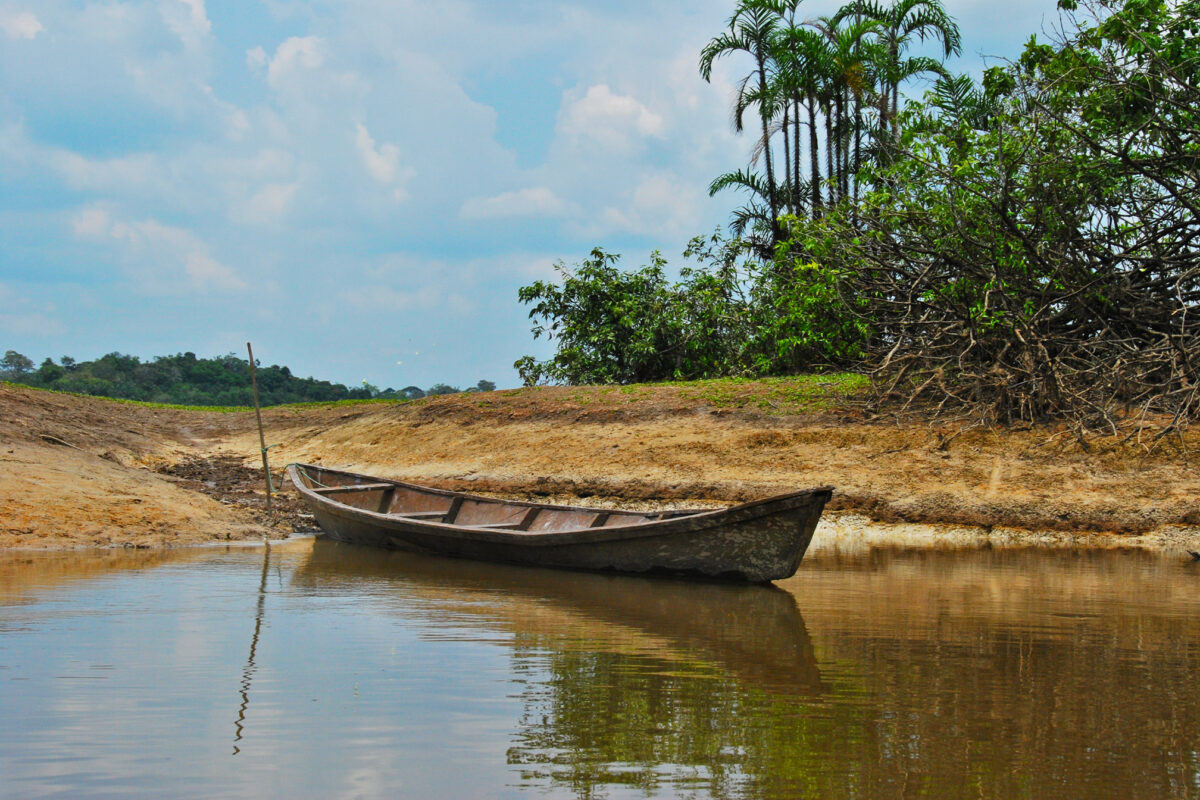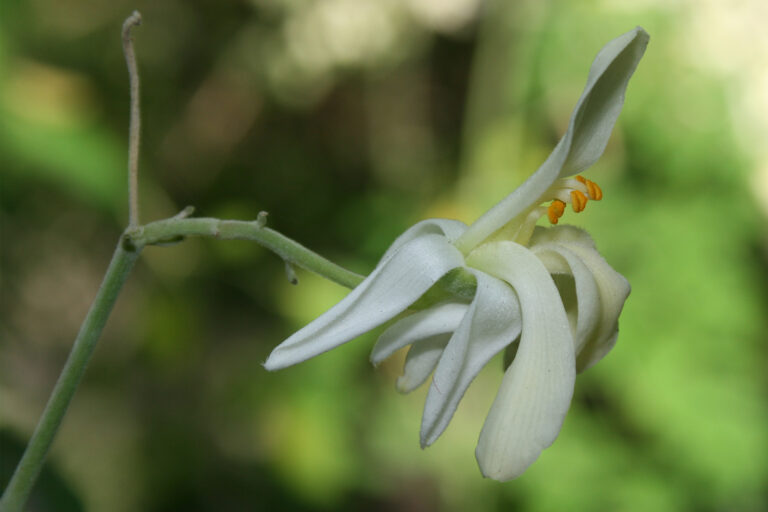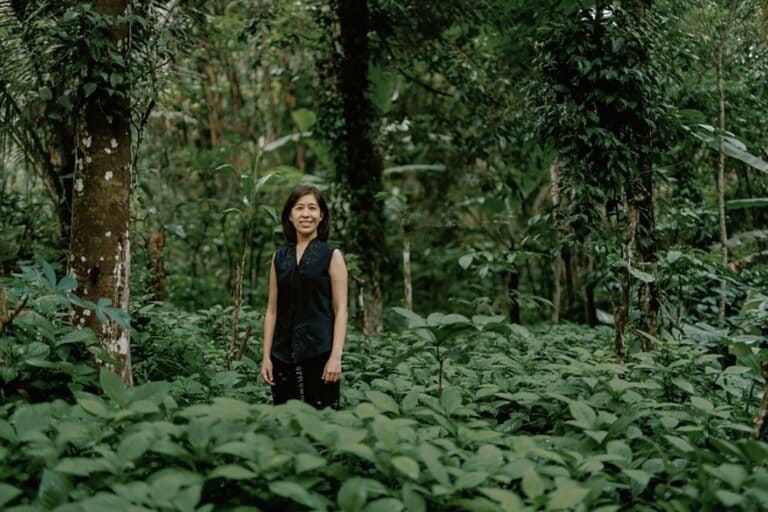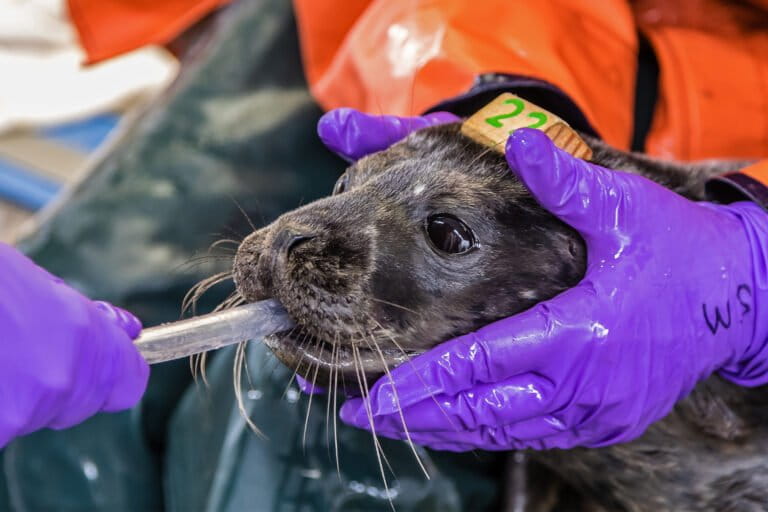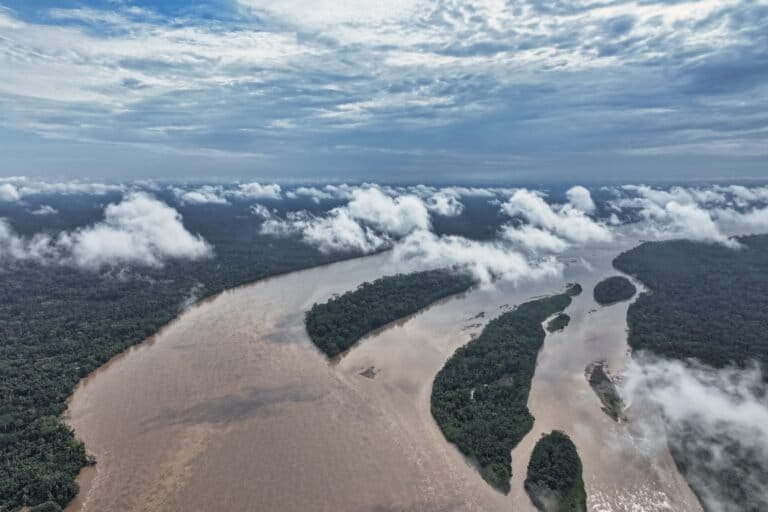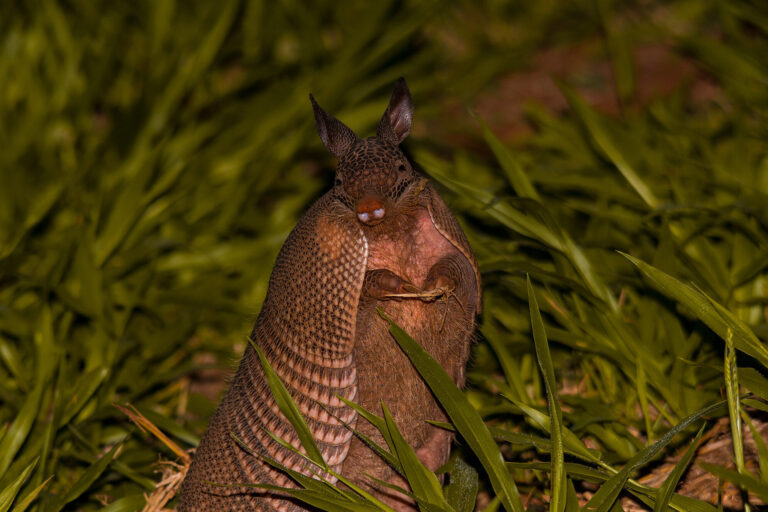- Researchers have described five new species of snail-eating snakes from the upper Amazon Rainforest in Ecuador and Colombia and the Chocó-Darién forests of Panama.
- Three of the new species were named by actor Leonardo DiCaprio, conservationist Brian Sheth, and the NGO Nature and Culture International to raise awareness about the threats these snakes face due to mining and deforestation.
- Ecuador and Colombia saw an increase in illegal gold mining along rivers and streams during the COVID-19 pandemic, which may have affected populations of these fragile snakes and has led to conflict and division within communities.
- Snail-eating snakes are arboreal and depend on wet environments to survive, so deforestation and mining pollution, including illegal gold mining, affect both the snakes and the snails and slugs that they rely on for food.
With its blood-red eyes and red, black and yellow scales, the Marley’s Snail-eating snake looks like it could end your life with a bite. But this delicate snake, Sibon marleyae, is harmless, as are the four other snail-eating snake species recently found in Panama, Ecuador, and Colombia.
Researchers described these five new-to-science snakes from the slopes of the upper Amazon Rainforest and the Chocó-Darién forests. Actor Leonardo DiCaprio, conservationist Brian Sheth, and the NGO Nature and Culture International (NCI) chose the names for three of the new species to honor loved ones and to raise awareness about the threats these snakes face due to mining and deforestation. The descriptions of the new snakes are published in the journal ZooKeys.

Snail-eating snakes, as their name implies, prey on the snails and slugs that thrive along streams and in other soggy places. These snakes are arboreal, meaning they stick to the trees and can’t survive in areas without vegetation.
The upper Amazon in Ecuador and Colombia and the Chocó-Darién rainforest of Panama, where the snakes were found, host a cornucopia of diversity — as well as some of the biggest deposits of gold and copper in the world. This is bad news for the tree-dwelling snakes.
Copper and gold are mined in open pits and along rivers, generating toxic waste in the process. Mining requires a lot of water, and when it flows through the mines, it picks up harmful substances like sulfur and other heavy metals, resulting in acid mining drainage. All of this leads to air, soil and water contamination.

Additionally, forests must be cleared to create mining pits, camps for workers and equipment, and often new roads. When the forest is cut, it not only destroys and fragments the habitat of snakes and other wildlife, but can also dry out the edges and patches of remaining forests.
“These [snake] species are delicate and used to living in very humid parts of the forest,” Abel Batista a scientist from the Autonomous University of Chiriquí in Panama, who helped find and describe the new species, told Mongabay. “Once we open the forest, if they don’t have a place to go, they just die.”
Deforestation and mining pollution are also affecting the snakes’ main food source: snails. Snails need clean water and humidity to thrive. When the environment is too dry, it can be difficult for them to recover.

Ecuador and Colombia saw an increase in illegal gold mining along rivers and streams during the COVID-19 pandemic. With people under quarantine and supply chains disrupted, work opportunities became scarce, and some turned to mining to make a living.
“Anecdotally… [the] increase in illegal mining was driven by economic factors,” Matt Clark, president and CEO of Nature and Culture International (NCI), told Mongabay in an email. “Jobs in the formal economy disappeared. Informal economies like illegal mining became increasingly important revenue sources as the formal economy shrank. Organized crime probably was happy to step into the breach.”
This flurry of mining activity has affected the surrounding ecosystems, including these fragile snakes. “We have the impression that in the last years, these species have been less common than five years ago,” Batista said

In Ecuador, as recently as 2014, the rainforests around the Nangaritza River looked healthy, Alejandro Arteaga, an Ecuadoran biologist and the study’s first author said in a statement. But now, “it is a paradise no more. Hundreds of illegal gold miners using backhoe loaders have now taken possession of the river margins, which are now destroyed and turned into rubble.”
Mining is a threat to ecosystems but also divides communities between those who welcome the work and those who oppose the mines, recognizing the potential for long-term pollution from toxic heavy metals like mercury.
“Gains from mining employment are often short-term,” said Clark. “The costs and damages are long-lasting and broad. But immediate pressing needs can force people into these kinds of difficult choices.”

“Illegal mining has divided both Indigenous and mestizo communities in Nangaritza River Valley,” said Clark. “There are people on ‘both sides’ of the issue.”
“Some inhabitants who live near mining activities have been intimidated into not reporting or protesting against mining activities,” Trotsky Riera, Nature and Culture International’s regional coordinator for this part of Ecuador, told Mongabay by email. “For this reason, many of them put their safety and that of their families first.”
In May 2018, government officials in charge of regulating illegal mining in Ecuador were kidnapped by unknown assailants, and their vehicles burned, Riera said. The perpetrators were never caught. “The local inhabitants prefer not to talk about it. Some have even chosen to work in mining activities.”
“Illegal mining has complex political and socio-economic drivers, and it’s a problem across Latin America,” said Clark. “It’s difficult to combat because it’s so diffuse…think death by a thousand cuts.”
Only the government has the authority to stop illegal mining, Clark said, but often Latin American governments “lack resources and political will to address the problem.”

With the support of other organizations, such as the World Land Trust, Nature and Culture International has purchased private land to create the Maycú Nature Reserve, in southeastern Ecuador.
This 179,730 acre (72,734 hectares) reserve is home to thousands of species, including the newly described Welborn’s snail-eating snake (Dipsas welborni), jaguars (Panthera onca), orange-throated tanager (Wetmorethraupis sterrhopteron), and many others that live only in this forest and nowhere else on Earth.
“It is essential to conserve the few remaining forests as they are home to hundreds of species,” Riera said, “including some that are still unknown to humanity.”
Creating the reserve makes it much harder for miners to gain footholds, Clark said, as NCI, “will not allow [people] to pay us for access to mine within the reserve boundaries, whereas other landowners may be willing.”

Despite the protected area, illegal miners are closing in on Maycú Reserve and “making violent threats to anyone opposed to the extraction of gold,” Artega wrote in a press release. “Even rangers and their families are tempted to quit their jobs to work in illegal mining, as it is much more lucrative. A local park ranger reports that by extracting gold from the Nangaritza River, local people can earn what would otherwise be a year’s salary in just a few weeks.”
Still, Felipe Serrano, the Ecuador Country Director for NCI told Mongabay, “the creation of the Maycú Reserve has significantly prevented the entry of illegal mining.” They have been able to keep most of the river banks within the reserve intact, with the exception of around 15 acres (6 hectares) where the reserve has been invaded by illegal mining. This invasion, he said, “has not been controlled because our rangers and staff have been intimidated and their safety was at risk.”
This area, he adds, is “part of a much broader illegal mining front controlled by organized groups, which have been violent at times and extends significantly outside of the Reserve border to the south.”
Authorities have not effectively intervened to stop illegal mining, Serrano said, and “the response of the justice system has been intermittent and marginal.”

Meanwhile, in Panama, two of the new species — Sibon irmelindicaprioae (named for Leonardo Dicaprio’s mother) and Sibon canopy, face threats from legal mining. One corporation: Minera Panamá S.A., a subsidiary of Canada-based mining and metals company First Quantum Minerals Ltd., is operating a large-scale copper mine in the Chocó-Darién rainforest large enough to be detected in satellite imagery.
The NGOs Nature and Culture International, Khamai, and Adopta Bosque say they are working on protecting the snakes’ habitat in Ecuador and Panama and raising awareness about the dangers of mining.
“Both legal and illegal open-pit mines are uninhabitable for the snail-eating snakes,” Arteaga said, “and most everything else that lives there too.”
Citation:
Arteaga, A., & Batista, A. (2023). A consolidated phylogeny of snail-eating snakes (Serpentes, Dipsadini), with the description of five new species from Colombia, Ecuador, and Panama. ZooKeys, 1143, 1-49. doi:10.3897/zookeys.1143.93601
Banner image: Marley’s Snail-eating (Sibon marleyae), found in Ecuador and Colombia, was named in honor of a young nature lover, Marley Sheth, the 11-year-old daughter of Brian and Adria Sheth, both long-time supporters of biodiversity conservation. Image by Jose Viera.
Liz Kimbrough is a staff writer for Mongabay. Find her on Twitter @lizkimbrough
Also by this reporter:
In Ecuador, communities protecting a ‘terrestrial coral reef’ face a mining giant
Related listening from Mongabay’s podcast: We discuss a newly described unique ape species and a hydroelectric dam proposed for the center of the animals’ tiny territory further challenges this special species’ chances of survival. Listen here:
FEEDBACK: Use this form to send a message to the author of this post. If you want to post a public comment, you can do that at the bottom of the page.



